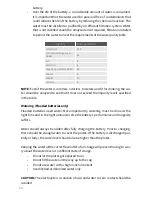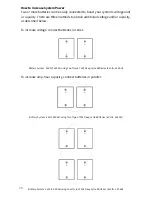
battery terminal protectant. Insulate the metal container to prevent the
metal can from contacting battery terminals which could result in an ex-
plosion.
•
Use care to connect the battery wires as shown. Tighten the battery post
hardware to 50 - 70 in. lbs. (6 - 8 Nm) torque. Protect the battery terminals
and battery wire terminals with a commercially available protective coat-
ing.
•
A new battery must mature before it will develop its maximum capacity.
Maturing may take up to 100 charge/discharge cycles. After the maturing
phase, the older a battery gets, the lower the capacity. The only way to de-
termine the capacity of a battery is to perform a load test using a discharge
machine following manufacturer’s recommendations.
Battery Connections
26
Prolonged Storage
• CAUTION:
Battery charger, controller and other electronic devices need
to be disconnected since they will contribute to the premature discharge
of batteries.
•
During periods of storage, the batteries will need attention to keep them
maintained and prevent discharge.
•
In high temperatures the chemical reaction is faster, while low tempera-
tures cause the chemical reaction to slow down. A vehicle that is stored
at 90° F (32° C) will lose .002 of specific gravity each day. If a fully charged
battery has a specific gravity of 1.275, and the battery is allowed to sit un-
used, it will become partially discharged. When it reaches 1.240, which it
will do in less than twenty days, it should be recharged. If a battery is left
in a discharged state, sulfating takes place on and within the plates. This
condition is not reversible and will cause permanent damage to the bat-
tery. In order to prevent damage, the battery should be recharged. A hy-
drometer can be used to determine the specific gravity and therefore the
Summary of Contents for BN72-08-AC-Autodrive-M
Page 34: ...34 6 Electrical Diagrams...
Page 35: ...35...











































